- Ficquelmont family
-
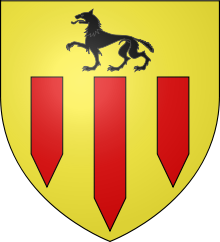 House of Ficquelmont, Coat of Arms[1]
House of Ficquelmont, Coat of Arms[1]
Nine-century-old[2] high nobility Lorrainerinct family ranking among the prominent of the Holy Roman Empire, Lorraine, Austria and Hungary, France, Russia and Belgium.
Contents
Origins
According to the legends, the House of Ficquelmont traces its origin back to the Merovingian times, some authors[3] have listed its members since "Conrad de Ficquelmont, who they say lived in 781"[4]. However, the family -comital since the 14th century[5]- is formally known since the early 12th century with the named Gerard de Ficquelmont, knight, in the year 1130 and the complete proven genealogy begins with the descendance of Erard de Ficquelmont, knight, before 1277[6]. Because it is a Lorrainer family, it owns a dual nobility, both French and German. According to the classes of the French nobility, it is part of both the Noblesse chevaleresque[7] and the Noblesse d'épée (Nobility of the Sword)[8]. According to the classes of the German nobility, it is part of the Uradel [9] and Hochadle (with the form of address Hochgeboren).
The family's estates were originally surrounding the ancient locality of Ficquelmont[10] where they had built a castle, in the current French region of Lorraine. From there the family has risen within the Lorrainer, Holy Roman, French and Austrian nobilities and eventually spread all across Europe following the French Revolution. Therefore, the ten-century-old[2] high nobility Lorrainer family ranks among the most prominent high nobles of the Holy Roman Empire, Lorraine, Austria and Hungary, France, Russia and Belgium [11][12][13][14].
Lorraine
The House of Ficquelmont "belongs to the very ancient Chivalry of Lorraine, [where] it has long been one of the most prominent noble family due to its antiquity and alliances"[15]. Indeed, descendant from the Capetian Royal dynasty [16], it is one of the oldest European continuous noble lineage [2] as it has at been referred as part of the nobility at least at the eve of the Holy Roman Empire.
The family members own numerous titles among which are Counts of Ficquelmont, of Parroy, of Champcourt, of Bathelémont, Counts of the Holy Roman Empire[17], Barons in Lorraine and Knights of Lotharingia. For centuries, members of the House of Ficquelmont had been some of the most prestigious Great Officers of the Ducal Court of Lorraine: chamberlains, masters of ceremonies or commanders of the Dukes. In the 17th and 18th century were:
- Count Leonard de Ficquelmont[18] colonel of Charles IV, Duke of Lorraine, commanding the prestigious Blainville regiment
- Count Robert de Ficquelmont, Great-chamberlain of Charles III, Duke of Lorraine
- his grand-son, count Jean-François de Ficquelmont[19], Great-chamberlain and colonel of the guard of Leopold I, Duke of Lorraine, commanding the dukal cavalry
- his son, Reichsgraf Charles de Ficquelmont Great-chamberlain of Francis I of Lorraine, Holy Roman Emperor, colonel of HIM's cuirassiers commanding the imperial guard's cavalry
- his son, Reichsgraf Jacques-Charles de Ficquelmont[19], colonel of the guard and Great-chamberlain of Francis I of Lorraine, Holy Roman Emperor, commanding the cavalry regiment of Kalchreuth then of Thun.
The Ficquelmonts, true to their knightly origin (European noblemen were originally mounted warriors who swore allegiance to their Sovereign and promised to fight for him), took part of the chivalry Orders of Saint John of Jerusalem of Rhodes and of Malta, of the Golden Fleece[20] and of the Dragon. They also often fought as warlords at the service of France, Spain and the Papacy[21]. The perfect illustration is Count Leonard de Ficquelmont[22], colonel of King Philip V of Spain who died in 1709 during the War of the Spanish Succession in Cataluna.
After Empress Maria Theresa of Austria had married Emperor Francis of Lorraine, the family enter the Austrian nobility, serving under the rule of the Habsburg. But, by the Treaty of Vienna, the duchy of Lorraine became part of the Kingdom of France. As member of the high nobility, the House of Ficquelmont was allowed by Royal decree to choose to serve and live as they pleased either in France or in the Empire.
France and Austria
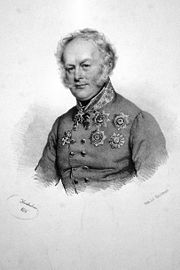 Hochgeboren Count Charles Louis de Ficquelmont, Minister-President of the Austrian Empire
Hochgeboren Count Charles Louis de Ficquelmont, Minister-President of the Austrian Empire
They resolutely choose France: count Charles Henri introduced all of his children to the Sovereign at the Royal Court of Versailles, such presentations were only granted to the members of the noblest families [23] and therefore established the House of Ficquelmont among France's high nobility.
By 1789, the French Revolution has started, bringing sorrow to the family. Indeed Counts of Ficquelmont, as aristocrats, were targeted by the Revolution, several members of the family were beheaded [12] and the family was divided into two main lines.
One stayed in France while the other chose to emigrate to Austria where it has kept close ties (for instance, Reichsgraf Charles de Ficquelmont (1724–1792), had followed Francis I of Lorraine, Holy Roman Emperor at the Imperial Court of Vienna when he was 12 and had stayed there ever since serving as colonel of the Imperial guard and (from 1764) Great-chamberlain of Emperors Francis I and Joseph II[24]) various estates and strong supports all the way to the Habsburgs themselves (for instance, Archduchess Marie-Christine personnally placed count Joseph de Ficquelmont in Emperor Leopold II's care in a letter dated from January 30, 1792[25]). This branch took part of the counter revolutionary's Army of the Princes and Imperial Austrian Army. It is best represented by Count Charles Louis de Ficquelmont, born in the castle of Dieuze on March 23, 1777 and who succeed Prince Klemens von Metternich as acting Minister-President of the Austrian Empire and married countess Dorothea von Tiesenhausen. Since the beginning of the 20th century the Austrian branch has no issue.
The French line is the last remaining. Each generation of the family was distinguished by the France's highest decoration Legion of Honor [26]- almost a unique case in the Legion's history. From that branch are Clotilde de Vaux (1815–1846), which was made Goddess of Wisdom of the Religion of Humanity [27] by philosopher Auguste Comte; Maximilien-Marie de Ficquelmont (1815–1891), famous French mathematician who resolved one of the most difficult problem of equational mathematics by inventing the imaginary number i [28]; Armand-Marie de Ficquelmont (1909–1998), French scientist whose researches helped discovering heavy water and therefore developing nuclear physics[29][30][31].
Marriages and residences
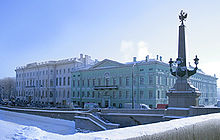 view of Palace Ficquelmont, St-Petersbourg
view of Palace Ficquelmont, St-Petersbourg
Marriages
The family is tied to Princes of Haraucourt, Princes von Clary und Aldringen, Princes Kutuzov, Princes Radziwill, Princes of Ligne, Counts de la Marche, Counts Butler of the Holy Roman Empire, Counts of Tiesenhausen, House of Vaudémont, House of Choiseul, House of Hohenzollern-Hechingen, House of Esterházy, House of Chatelet, House of Salm, House of Chotek and many others.
Residences
There are Ficquelmont palaces in Venice, Vienna and St.Petersburg; the original family's castle in the locality of Ficquelmont (Thumeréville, current region of Lorraine, France) was burned down in 1877. However, many others estates were properties of the family over the ages including the Lorrainer châteaux of Parroy, Dieuze (those two serving as primary homes and center of administration of the Ficquelmont family during the late 18th century), Mars la Tour, Bathelémont, Moustier, Champcourt, Puxe and outstanding hotel particuliers in Nancy, Karlsruhe, Strasbourg and Prague.
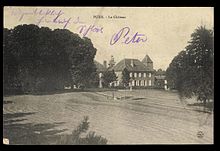 View of "château de Puxe" (circa 1914)
View of "château de Puxe" (circa 1914)
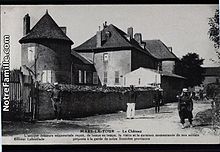 View of "château de Mars-la-Tour"
View of "château de Mars-la-Tour"
 View of "château de Woippy"
View of "château de Woippy"
Titles and Blazon
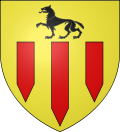 House of Ficquelmont, Coat of Arms[1]
House of Ficquelmont, Coat of Arms[1]
Titles
[32] The Ficquelmont family is comital since the 14th century[5] and has been raised to Counts of the Holy Roman Empire[33] with the style of address of Erlaucht (Illustrious Highness) in the 18th century by Francis I of Lorraine, Holy Roman Emperor.
- Lords of Ficquelmont and hereditary knights of Lorraine (known before 1130);
- Counts of Mars la Tour (1473);
- Counts of Chaumont[disambiguation needed
 ] (1605);
] (1605); - Counts of Parroy (1709);
- Counts of Ficquelmont (1710)[34];
- Counts of Ficquelmont and of the Holy Roman Empire (1736)[35][36].
For Count Antoine-Charles de Ficquelmont (1753–1833) and his descendants:
- Counts of Ficquelmont (Title recreated within the Dutch nobility July 16, 1822) ;
- Counts of Ficquelmont de Vyle when became Belgian after the 1830's Revolution; became extinct in male line in 1909; used as a courtesy title (France and Belgium).
Furthermore, the Ficquelmonts have been seigneurs (lords) of Puxe, Moustier, la Tour en Voivre, Dieuze, Champcourt and Bathelémont.
Coat of Arms
The blazon of this family coat of arms is: gold, three enhanced pickets gules, ensigned with a passant wolf sable.
The family's motto is "Nul ne m'atteint"[37] (modern French translation) (literally: "No one reaches me") meaning both "No family is more noble" and "No one could defeat me" referring to their 10-century-old noble legacy and their warlike origin.
Bibliography
- Alain Petiot, Au service des Habsburg, 1999
- Alain Petiot, Les Lorrains et l'Empire, 2005
References
- ^ a b Armorial du Pays de Luxembourg (p. 359), Loutsch, Jean-Claude
- ^ a b c See below: references to Gerard de Fiquelmont, knight, in 1130 then to Pierre de Fiquelmont, knight, before 1277; The French Nobility Book by Régis Valette (2001) has traced its continuious proven references as far as 1386.
- ^ such as Georges van Santern in Moniteur de la Noblesse Belge (Book of the Belgian nobility), Brussels, 1890
- ^ "Conrad de Ficquelmont qu'ils font vivre en 781"Quote from the introduction paragraph (the one listing its mythical origins) of the House of Ficquelmont's article in l'Intermédiaire des chercheurs et des curieux, Volume 47, p.810, Paris, 1903 [1]
- ^ a b House of Ficquelmont's article in l'Intermédiaire des chercheurs et des curieux, Volume 47, p.810, Paris, 1903 [2]
- ^ [3] in La Belgique héraldique, Charles Poplimont,1866, Brussels
- ^ nobility of antique military origin from before the year 1400
- ^ or noblesse de race or noblesse ancienne: the traditional or old nobility, heir of militaristic traditions
- ^ German term referring to nobility tracing back to at least 1400
- ^ now Thumeréville
- ^ [4] The House of Ficquelmont is one of the oldest, noblest, most honoured family of the ancient Lorrainer Chivalry in La Belgique héraldique, Charles Poplimont,1866, Brussels
- ^ [5] (The St.Petersbourg's Ficquelmont Palace) provided the setting of two of the most famous Salons of the period (1830's), reigned over by Ficquelmont's wife (grand-daughter of Prince Kutuzov) in Personnality and Place in Russian Culture, Essays in Memory of Lindsey Hughes, Simon Dixon, 2010, History
- ^ [6] Member of the Association of the French nobility
- ^ [7] Member of the Belgian Nobility
- ^ La famille de Ficquelmont "appart[ient] a la vieille chevalerie de Lorraine, elle [y fut] l'une des plus distinguée par son ancienneté et ses alliances" Famille de Ficquelmont in l'Intermédiaire des chercheurs et des curieux, Volume 47, p.810, Paris, 1903
- ^ File:http://209.85.135.104/search?q=cache:OW8ad7sMY4IJ:www.capet.org/liste_eclair.php+de+Ficquelmont&hl=fr&ct=clnk&cd=12&gl=fr La Descendance Capétienne — Recensement de tous les descendants d'Hugues Capet dont la filiation est encore représentée en 2009
- ^ [8] The Heraldic Belgique, 1866
- ^ not to be mistaken for his grand-son, count Leonard de Ficquelmont, colonel of King Philip V of Spain who died in 1709 during the War of Spanish (see next paragraph)
- ^ a b Woelmont, Op. cit., p. 343-344.
- ^ http://webcache.googleusercontent.com/search?q=cache:nZKccLntNIAJ:www.napoleon-series.org/research/biographies/Austria/AustrianGenerals/c_AustrianGeneralsF.html+golden+fleece+ficquelmont&cd=6&hl=fr&ct=clnk&gl=fr Charles-Louis de Ficquelmont, Knight of the Golden Fleece
- ^ Count Henri de Ficquelmont, son of count Jean de Ficquelmont was colonel of Popes Clement XI and Innocent XIII
- ^ not to be mistaken for his grand-father, count Leonard de Ficquelmont, colonel of Charles IV, Duke of Lorraine (see previous paragraph)
- ^ [9] Note: Honour of the Court of France (French)
- ^ "Charles, comte de Ficquelmont, Lorrain de naissance, n'avait que douze ans lorsque le duc François de Lorraine, plus tard empereur François Ier, l'emmena en Autriche. Après avoir servit comme page a la Cour imperiale, il fut nommé officier de l'armée [...] il fut nommé grand chambellan en 1764" in Florimond Claude Charles de Mercy-Argenteau, Correspondance secrète entre Marie-Thérèse et le Comte de Mercy, Volume 1, 1874, p.185
- ^ "Marie-Christine à l'Empereur Leopold II , Ce 30 de l'an 792 (30 janvier 1792) [...] le capitaine Ficquelmont, qui est aux grenadiers de Vienne, vours remettra [cette lettre]. J'ose vous le recommander tout particulièrement comme s'étant distingué dans la guerre turque et pour ce que l'on dit de sa conduite et de son caractère [...]" in Félix Feuillet de Conches, Louis XVI, Marie-Antoinette et Madame Élisabeth: lettres et documents inedits Tome V, page 154, Paris, Henri Plon, 1869
- ^ [10]
- ^ http://www.britannica.com/EBchecked/topic/624197/Clotilde-de-Vaux
- ^ [11] Théorie des fonctions de variables imaginaires, tomes I à III, Gauthier-Villars, 1874-1876, 3 vol.
- ^ http://www.nature.com/nature/journal/v137/n3468/abs/137674a0.html
- ^ http://webcache.googleusercontent.com/search?q=cache:AfN9ynCYLfcJ:gallica.bnf.fr/ark:/12148/bpt6k31562/f1180.table+armand+marie+de+ficquelmont&cd=3&hl=en&ct=clnk&gl=us
- ^ http://www.sciencedirect.com/science?_ob=ArticleURL&_udi=B6TGB-45353MW-1V&_user=10&_coverDate=12%2F23%2F1988&_rdoc=1&_fmt=high&_orig=search&_origin=search&_sort=d&_docanchor=&view=c&_searchStrId=1484558732&_rerunOrigin=google&_acct=C000050221&_version=1&_urlVersion=0&_userid=10&md5=aeb16c1b3db7dffe58bf41fcae4654b5&searchtype=a
- ^ Sources: Woelmont de Brumagne, Notices généalogiques, 7e série, p.343-344/Association d'entraide de la noblesse francaise (ANF), June 12, 1954 ANF
- ^ in Charles Poplimont, La Belgique héraldique, 1866, Brussels
- ^ Honnors of the French Court (Honneurs de la Cour), 1777 and 1789
- ^ The title of Reichsgraf was also personnaly granted to Count Jacques-Charles de Ficquelmont, colonel and Chambellan of the Holy Roman Empereur
- ^ See also list of counts of Austria-Hungary
- ^ Source: Rietstap
Sources
- Alain Petiot, Au service des Habsburg, 1999
- Alain Petiot, Les Lorrains et l'Empire, 2005
- The French Nobility Book: Régis Valette, Catalogue de la noblesse française (Robert Laffont, Paris, 2007)
- Jougla de Morénas, Grand armorial de France, n° 15355
- Woelmont de Brumagne, Notices généalogiques, 7e série, p. 340.
- Poplimont, La Belgique héraldique: recueil historique, chronologique, généalogique et biographique..., t. IV, Paris : 1866.
Categories:- French noble families
- French nobility
- Lorraine nobility
- German noble families
- Austro-Hungarian people
- Austrian nobility
- Belgian nobility
- Russian nobility
- Belgian people of French descent
- Austrian people of French descent
- Russian people of French descent
- Counts of the Holy Roman Empire
- Counts of France
- Counts of Austria
- Counts
- Légion d'honneur recipients
Wikimedia Foundation. 2010.
